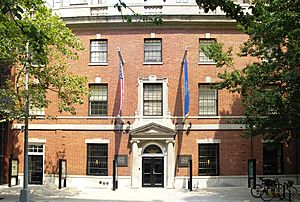YIVO facts for kids

Front entrance of YIVO in New York City
|
|
| Established | 1925 |
|---|---|
| Location | 15 West 16th Street, Manhattan, New York, United States |
| Public transit access | Subway: 14th Street–Union Square |
YIVO is a special organization that helps keep the history and culture of Jewish people alive. It focuses on Jewish life in places like Eastern Europe, Germany, and Russia. YIVO also studies the Yiddish language, including how it's written and its words.
It was started in 1925 in a city called Wilno, which is now Vilnius, Lithuania. Back then, it was known as the Yiddish Scientific Institute. The word yidisher means both "Yiddish" and "Jewish."
Later, YIVO moved to New York City. Its English name became the Institute for Jewish Research. But most people still call it YIVO, using its original Yiddish short name. Today, YIVO works with the Center for Jewish History. It's also seen as the main group that sets the rules for the Yiddish language in the non-religious world. The way YIVO teaches Yiddish is often called "standard language" or "YIVO Yiddish" in universities.
Contents
What YIVO Does
YIVO works hard to save important items like old handwritten papers, rare books, and diaries. These items help us learn about Yiddish culture.
YIVO's Amazing Collections
The YIVO Library in New York has over 385,000 books. Some of these books are very old, dating back to the 1500s! About 40,000 of these books are in Yiddish. This makes YIVO's library the biggest collection of Yiddish books anywhere.
The YIVO archives hold even more items. They have over 23 million documents, photos, recordings, posters, and films. Together, these collections are the largest in the world. They tell the story of Jewish people from Central and Eastern Europe. They also show what life was like for Jewish immigrants in America. The archives and library have items in many languages. These include English, French, German, Hebrew, Russian, Polish, and Judaeo-Spanish.
Publishing Books and Magazines
YIVO also publishes books and magazines in Yiddish. Some of its well-known publications include YIVO Bleter (started in 1931) and Yidishe Shprakh (started in 1941). It also publishes books and magazines in English, like the YIVO Annual of Jewish Social Studies.
The History of YIVO
The idea for YIVO first came from a Yiddish language expert named Nochum Shtif. He believed that supporting Yiddish was a practical way to help Jewish people. Other important founders were language expert Max Weinreich and historian Elias Tcherikower.
Starting in Europe
YIVO officially began at a meeting in Berlin in 1925. But its main office was in Vilnius, which had a large Jewish population. In its early days, YIVO also had offices in Berlin, Warsaw, and New York City. Over the next ten years, smaller groups of YIVO started in many other countries where Ashkenazi Jewish people lived.
Many smart people helped lead YIVO in its first decades. They studied history, psychology, education, and economics. Famous thinkers like Albert Einstein and Sigmund Freud were even on YIVO's honorary board.
Training Future Scholars
From 1934 to 1940, YIVO had a special program called the Aspirantur. This program trained students to do their own research in Jewish studies. Many students studied how Jewish people lived in the Vilnius area at that time.
Moving to New York
When the Nazis began to take over Eastern Europe, YIVO had to move its main operations. It moved to New York City to keep its work safe. Another important YIVO center was also set up in Buenos Aires, Argentina.
Sadly, the Nazis stole some of YIVO's archives from Vilnius. They wanted to use these documents for their own harmful purposes. But after World War II, the U.S. Army found these documents and sent them to YIVO in New York.
Saving Important Collections
The YIVO Library was also looted by the Germans. However, a brave group called "The Paper Brigade" managed to sneak out many books. They saved them from being destroyed. Later, a Lithuanian librarian named Antanas Ulpis saved even more materials from the Soviets. These items are now kept in Lithuania.
In 2014, YIVO started a big project called the Edward Blank YIVO Vilna Online Collections. They are working with the government of Lithuania to do this. Their goal is to save and digitize over 1.5 million documents and about 12,200 books. These items cover 500 years of Jewish history in Eastern Europe and Russia.
Today, YIVO still has active centers in New York City, Buenos Aires, and Chicago.
See also
- Academy of the Hebrew Language, for the Hebrew language
- Autoridad Nasionala del Ladino, for the Ladino language
- Dina Abramowicz (a long-time YIVO librarian)
- Yiddish Book Center
- League for Yiddish

